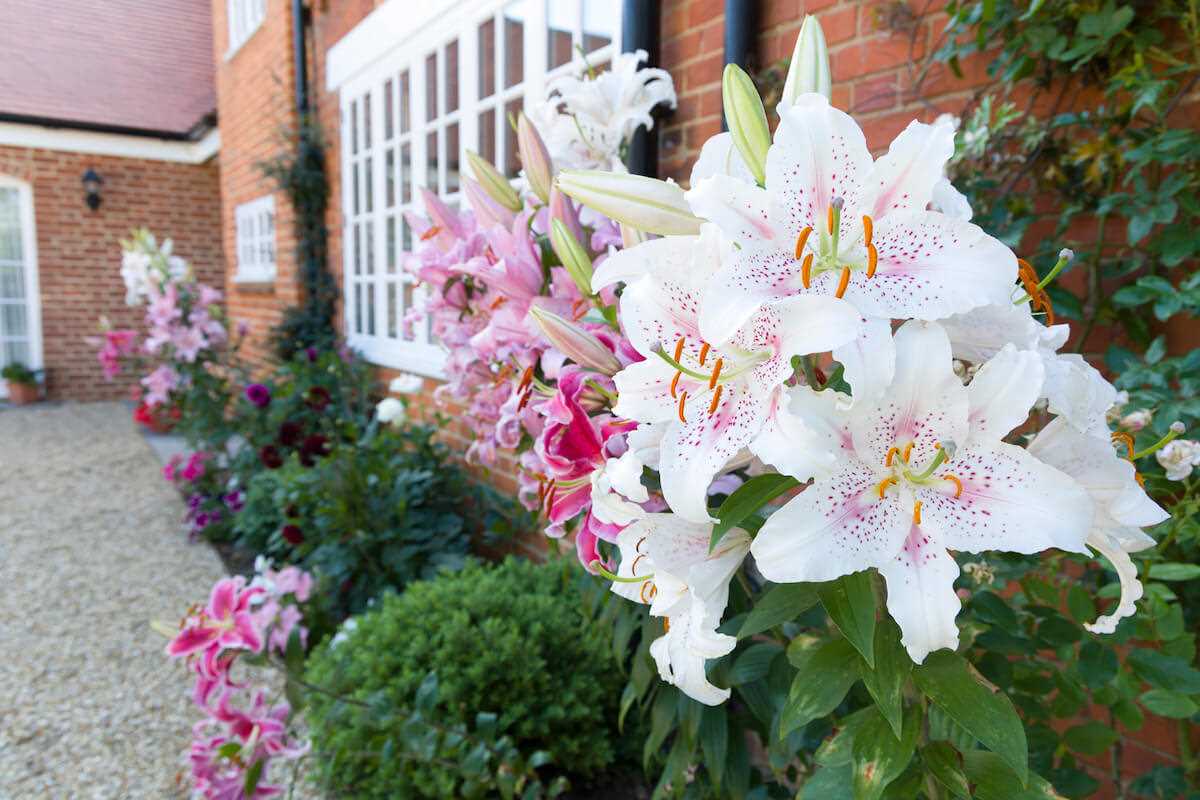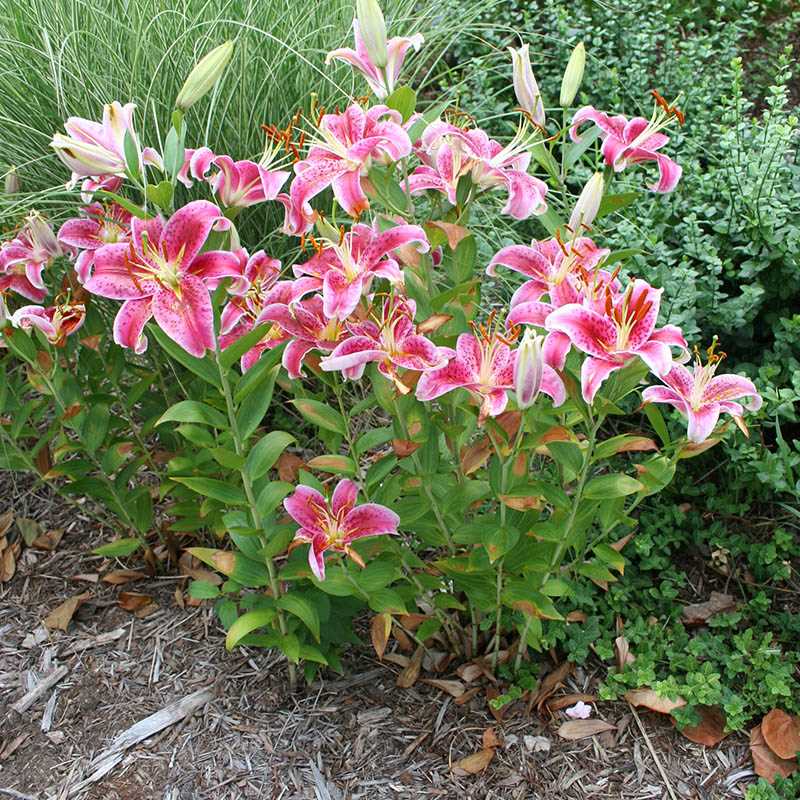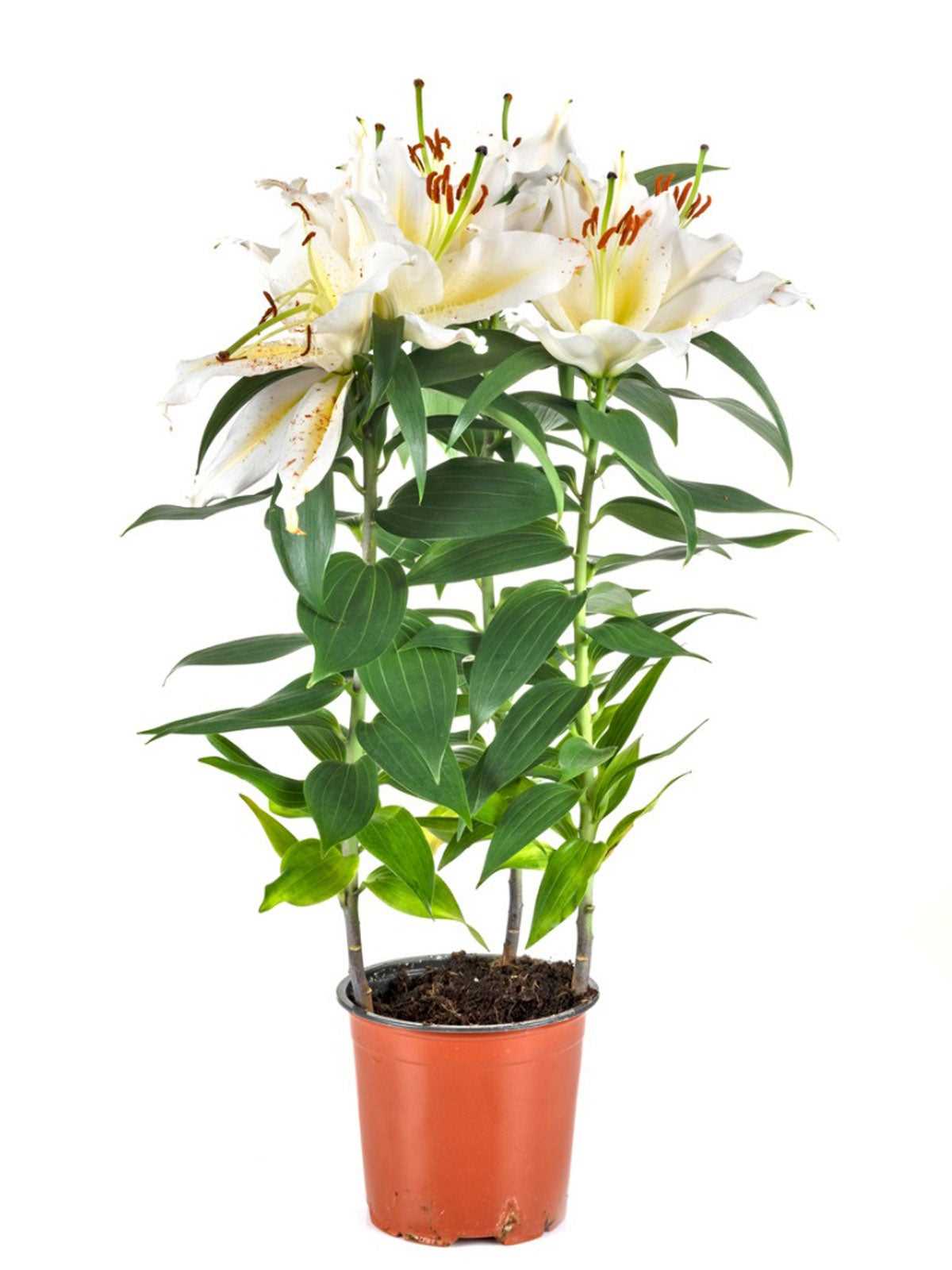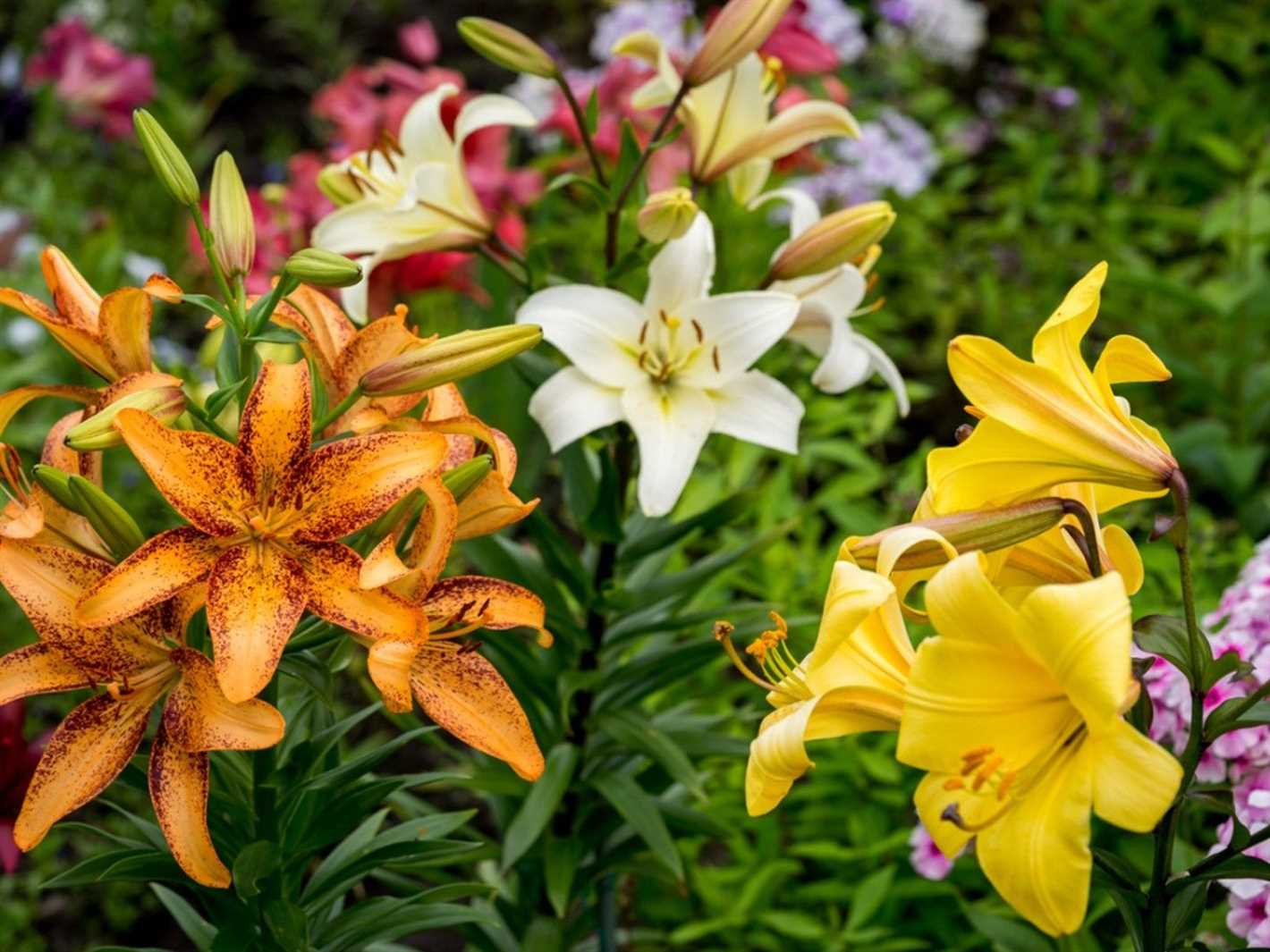- Choosing the Right Lily Variety
- Consider the Growing Conditions
- Choose the Right Size
- Select the Desired Bloom Color and Fragrance
- Research Different Lily Varieties
- Consider Companion Planting
- Preparing the Soil for Lily Planting
- 1. Choose the Right Location
- 2. Clear the Area
- 3. Test the Soil
- 4. Amend the Soil
- 5. Improve Drainage
- 6. Avoid Heavy Clay Soils
- 7. Loosen the Soil
- 8. Mulch the Soil
- 9. Water the Soil
- Best Time to Plant Lilies
- Spring Planting
- Fall Planting
- Consider Your Climate
- Selecting the Planting Location
- Light
- Soil
- Moisture
- Temperature
- Protection
- Spacing
- Planting Lily Bulbs
- Choose a Suitable Location
- Prepare the Soil
- Dig the Hole
- Plant the Bulb
- Water Thoroughly
- Mulch the Area
- Stake Tall Varieties
- Protect from Wildlife
- Maintain Regular Care
- Enjoy the Blooms
- Watering and Fertilizing Lilies
- Watering
- Fertilizing
- Caring for Lilies during Growth
- Watering
- Feeding
- Staking
- Mulching
- Deadheading
- Pest and Disease Control
- Common Pests and Diseases of Lilies
- Pests:
- Diseases:
- Prevention and Control:
- Questions and Answers:
- What are some tips for planting lilies?
- Can lilies be grown in containers?
- When is the best time to plant lily bulbs?
- How deep should lily bulbs be planted?
- What are some common pests and diseases that affect lilies?
- Videos: Grow Your Own Lilies In Just 99 Days! Growing lily bulbs indoors planting lilies in pots

If you love the beauty and elegance of lilies, then you should consider planting them in your garden. Lilies are not only stunning, but they also come in a wide variety of colors and sizes, making them a versatile choice for any landscape. In this guide, we will provide you with all the tips and techniques you need to successfully plant lilies in your garden.
Lilies can be planted in both containers and in the ground, depending on your preference and the available space in your garden. If you choose to plant them in the ground, make sure to select a well-draining spot with full or partial sun. Lilies thrive in soil that is rich in organic matter and slightly acidic. Adding compost or well-rotted manure to the soil before planting will help ensure that your lilies receive the nutrients they need to grow and bloom.
Before planting your lilies, it is important to prepare the soil properly. Remove any weeds or grass from the planting area and loosen the soil to a depth of about 12 inches. This will help the lily bulbs establish their roots and grow properly. If you are planting lilies in containers, choose a pot that is at least 12 inches deep and fill it with well-draining potting soil.
When planting lilies, it is important to consider their depth and spacing. The general rule of thumb is to plant lily bulbs at a depth that is three times their height. For example, if a bulb is two inches tall, it should be planted six inches deep. As for spacing, lilies should be planted about six to eight inches apart to allow for proper air circulation and prevent overcrowding.
After planting, water your lilies thoroughly to help settle the soil and provide moisture for the initial growth. Keep the soil evenly moist but not waterlogged, as lilies do not like to sit in water. Mulching around the lilies will help retain moisture in the soil and suppress weed growth. As your lilies grow, be sure to provide them with a stake or support system to help keep them upright.
With proper care and maintenance, your lilies will reward you with beautiful blooms year after year. Regularly deadhead the faded flowers to encourage more blooms and remove any damaged leaves or stems. In the fall, after the foliage has turned yellow and died back, you can cut it down to the ground and apply a layer of mulch to protect the bulbs during the winter months.
By following these tips and techniques, you can enjoy the beauty of lilies in your garden and create a stunning display that will leave your neighbors green with envy. So go ahead and start planting lilies today!
Choosing the Right Lily Variety
When it comes to choosing the right lily variety for your garden, there are several factors to consider. From the size of the plant to the color and fragrance of the blooms, each lily variety offers its own unique characteristics. Here are some tips to help you select the perfect lily variety for your garden:
Consider the Growing Conditions
- Sunlight: Different lily varieties have different sunlight requirements. Some varieties thrive in full sun, while others prefer partial shade. Make sure to choose a variety that is suitable for the amount of sunlight available in your garden.
- Soil Type: Lilies prefer well-draining soil. Before selecting a variety, consider the type of soil in your garden. If you have heavy clay soil, choose a variety that is more tolerant of this soil type.
- Hardiness Zone: Lilies come in a wide range of hardiness zones. Make sure to choose a variety that is recommended for your specific hardiness zone to ensure that it will thrive in your garden.
Choose the Right Size
Lilies come in various sizes, ranging from small dwarf lilies that are perfect for containers, to tall lilies that can tower over the rest of your garden. Consider the height and spread of the lily variety when choosing, and ensure that it will fit well into your garden design.
Select the Desired Bloom Color and Fragrance
Lilies are known for their beautiful blooms and captivating fragrance. Consider the color palette of your garden and choose a lily variety that will complement it. From vibrant oranges and yellows to soft pinks and whites, there are lilies available in a wide array of colors. Additionally, lilies vary in fragrance, so if fragrance is important to you, make sure to choose a variety known for its pleasant scent.
Research Different Lily Varieties
With countless lily varieties available, it’s important to do some research to find the perfect one for your garden. Look for reputable sources like gardening websites, books, and catalogs that provide detailed information about each variety. Pay attention to characteristics such as bloom size, bloom time, and disease resistance to make an informed decision.
Consider Companion Planting
Lilies can be complemented by other plants in your garden through companion planting. Consider surrounding your lilies with companion plants that will enhance the overall aesthetic and provide additional benefits such as attracting beneficial insects or repelling pests. Some recommended companion plants for lilies include daylilies, hostas, and lavender.
By considering these factors and doing your research, you can choose the right lily variety to create a stunning and fragrant garden that will be the envy of your neighbors.
Preparing the Soil for Lily Planting
Before planting lilies, it is important to prepare the soil to provide the best conditions for growth. The soil should be rich in nutrients and well-draining, as lilies prefer a moist but not waterlogged environment.
1. Choose the Right Location
Selecting the right spot for planting lilies is essential. Lilies generally require full sun to bloom and thrive, so choose a location that receives at least 6 to 8 hours of direct sunlight per day.
2. Clear the Area


Clear any weeds, rocks, or debris from the chosen planting area. Weeds compete with lilies for nutrients and moisture, so it is crucial to remove them before planting.
3. Test the Soil
Testing the soil can provide valuable information about its pH levels and nutrient content. Lilies prefer slightly acidic to neutral soil, with a pH range of 6.0 to 7.0. Use a soil testing kit to determine the pH level and adjust it if necessary.
4. Amend the Soil
If the soil is sandy or lacks organic matter, it may need to be amended. Incorporate organic matter such as compost or well-rotted manure into the soil to improve its fertility and water retention capacity. Mix the amendments thoroughly with the existing soil.
5. Improve Drainage
Lilies do not tolerate waterlogged soil, so if the soil retains too much moisture, it is essential to improve its drainage. One way to do this is by adding perlite or coarse sand to the soil to enhance its porosity and drainage ability.
6. Avoid Heavy Clay Soils
Avoid planting lilies in heavy clay soils, as they can become compacted and hinder root growth. If your soil is clayey, consider creating raised beds or containers filled with well-draining soil to plant your lilies in.
7. Loosen the Soil
Using a garden fork or a tiller, loosen the soil to a depth of about 10 to 12 inches. This will ensure that the lily bulbs can establish their roots easily and have access to sufficient nutrients.
8. Mulch the Soil
After planting the lilies, apply a layer of mulch around the plants. This will help conserve moisture, suppress weeds, and regulate soil temperature. Organic mulches like wood chips or shredded leaves are ideal for lilies.
9. Water the Soil
After preparing the soil, water it thoroughly to settle it and provide moisture for the lilies. The soil should be evenly moist, but not overly saturated. Monitor the moisture levels throughout the growing season and water as needed.
By following these soil preparation steps, you can create optimal conditions for planting lilies and ensure their successful growth and blooming.
Best Time to Plant Lilies
Lilies are beautiful and vibrant flowers that can add a touch of elegance to any garden or landscape. To ensure successful growth and blooming, it’s crucial to plant lilies at the right time. The timing of planting lilies can vary depending on the type of lily and your geographical location.
Spring Planting
Spring is generally the best time to plant lilies, as it allows them to establish their roots before the hot summer months. The optimal time to plant lilies in spring is typically early to mid-spring, once the soil has thawed and is workable. This ensures that the lilies have enough time to develop a strong root system before the heat sets in.
Fall Planting
In some regions, fall planting can also be successful for lilies. Fall planting is particularly beneficial for lilies that require a period of cold dormancy, such as Oriental and trumpet lilies. Planting these lilies in the fall allows them to go through their natural growth cycle and bloom beautifully in the following summer.
If you choose to plant lilies in the fall, it’s important to do so at least six weeks before the ground freezes. This gives the bulbs enough time to establish their roots before the winter months.
Consider Your Climate
When determining the best time to plant lilies, consider the climate of your region. Lilies prefer well-draining soil and require a certain amount of cold exposure to trigger their growth cycle. If you live in a region with mild winters, you may need to adjust the planting time accordingly.
Research the specific requirements for the type of lilies you intend to plant, as different varieties may have different preferences for planting times. Online resources or local gardening centers can provide valuable information about the ideal planting time for specific lily varieties in your area.
By planting lilies at the optimal time for your region and following proper planting techniques, you can ensure that your lilies thrive and produce stunning blooms year after year.
Selecting the Planting Location
When it comes to planting lilies, selecting the right location is crucial for their growth and overall health. Consider the following factors when choosing a planting spot for your lilies:
Light
Lilies thrive in full sun, so it is essential to select a location that receives at least 6-8 hours of direct sunlight each day. Without adequate sunlight, your lilies may not bloom or grow to their full potential.
Soil
Lilies prefer well-draining soil that is rich in organic matter. Before planting, make sure the soil is loose and crumbly. Avoid clay or compacted soil, as it can lead to waterlogged roots and increased risk of rot. If your soil is heavy, consider incorporating compost or organic matter to improve drainage.
Moisture
While lilies need well-draining soil, they also require consistent moisture. Make sure the planting location has access to regular watering, especially during dry periods. However, be cautious not to overwater, as it can lead to root rot.
Temperature
Lilies thrive in cool to moderate temperatures, typically between 40-75°F (4-24°C). Extreme heat can cause stress and may inhibit flowering. If you live in a region with hot summers, consider planting lilies in partially shaded areas or using a layer of mulch to keep the soil cool.
Protection
Select a planting location that offers some protection from strong winds, as they can damage lilies and cause them to bend or break. Planting near a fence, wall, or shrubs can provide the necessary shelter.
Spacing
Ensure that you give your lilies enough space to grow and spread. Plant bulbs at least 6-12 inches apart, depending on the variety. Proper spacing allows for good air circulation, which helps prevent disease and encourages healthy growth.
By considering these factors and finding the ideal planting location, you can provide the best conditions for your lilies to thrive and produce magnificent blooms.
Planting Lily Bulbs
Planting lily bulbs is an easy and rewarding gardening task. Follow these steps to ensure your lilies thrive:
Choose a Suitable Location
Lilies prefer well-draining soil and full sun or partial shade. Select a location that receives at least 6 hours of direct sunlight per day.
Prepare the Soil
Before planting, prepare the soil by loosening it with a garden fork or tiller. Remove any weeds or rocks that may hinder the growth of your lilies.
Dig the Hole
Dig a hole that is approximately 6-8 inches deep, and wide enough to accommodate the bulb. The hole should be large enough to allow for proper root development.
Plant the Bulb
Place the lily bulb in the hole with the pointed end facing up and the root side facing down. Fill in the hole with soil, gently firming it around the bulb.
Water Thoroughly
After planting, water the lily bulb thoroughly to settle the soil and provide moisture to the newly planted bulb.
Mulch the Area
Apply a layer of mulch around the base of the lily plant to help retain moisture and suppress weed growth. Use a natural mulch such as wood chips or straw.
Stake Tall Varieties
If you are planting tall lilies, it is recommended to stake them to provide support as they grow. This will help prevent them from bending or breaking in strong winds.
Protect from Wildlife
Squirrels, rabbits, and other wildlife may be attracted to lily bulbs. Consider using wire mesh or other protective measures to prevent animals from digging up the bulbs.
Maintain Regular Care
Once planted, lilies require regular care including watering, fertilizing, and removing dead flowers. Monitor the soil moisture level and provide additional water as needed.
Enjoy the Blooms
In a few months’ time, your lily bulbs will grow into beautiful plants with vibrant blooms. Enjoy their beauty in your garden or use them as cut flowers to bring indoors.
With the right planting techniques and care, your lilies will reward you with gorgeous flowers year after year.
Watering and Fertilizing Lilies
Proper watering and fertilizing are crucial for the health and beauty of your lilies. Here are some tips to ensure you provide the right care for your lilies:
Watering


Watering is a critical aspect of lily care, as they require consistent moisture to thrive. Here’s how to water your lilies effectively:
- Water your lilies deeply once a week, providing enough water to penetrate the root zone.
- Avoid shallow watering, as it may lead to shallow root development.
- Make sure the soil is moist but not waterlogged, as lilies do not tolerate waterlogged conditions.
- During hot and dry periods, you may need to water more frequently to keep the soil consistently moist.
- Avoid overhead watering, as it can promote the development of fungal diseases. Instead, use a drip irrigation system or water the base of the plants.
Fertilizing
Lilies require regular fertilization to promote healthy growth and abundant blooms. Follow these guidelines for fertilizing your lilies:
- Apply a slow-release granular fertilizer formulated specifically for lilies in early spring, following the package instructions for application rates.
- Alternatively, you can use a balanced liquid fertilizer every two to three weeks during the growing season.
- Ensure you do not overfertilize, as this can lead to excessive foliage growth at the expense of flower production.
- Avoid fertilizing lilies after mid-summer, as this can interfere with their natural dormancy period.
- If your lilies show signs of nutrient deficiencies, such as yellowing leaves or stunted growth, consider applying a foliar fertilizer spray.
Remember to always read and follow the instructions provided on the fertilizer packaging, as different products may have different application rates and guidelines. By providing adequate watering and regular fertilization, you will help your lilies thrive and reward you with beautiful blooms all season long.
Caring for Lilies during Growth
Once you have successfully planted your lilies, it is important to provide them with proper care during their growth period. Here are some essential tips to ensure healthy growth and beautiful blooms:
Watering
Proper watering is crucial for lilies. Keep the soil consistently moist, but not overly saturated. Water deeply, allowing the water to penetrate the root zone. Avoid getting the foliage wet as this can promote disease. Watering in the morning is preferable as it allows the plant to dry during the day.
Feeding


Fertilize your lilies regularly to provide them with the necessary nutrients. Use a balanced, slow-release fertilizer or a liquid fertilizer diluted according to the package instructions. Apply the fertilizer before the lilies start to bloom and continue every 4-6 weeks throughout the growing season.
Staking
Some lily varieties, particularly the taller ones, may require staking to prevent them from flopping over. Install stakes or plant supports when the shoots are about 6-8 inches tall. Gently tie the stems to the stakes using soft twine or plant ties, being careful not to damage the stems.
Mulching
Applying mulch around the base of lilies helps to conserve moisture, suppress weeds, and regulate soil temperature. Use a layer of organic mulch, such as straw or wood chips, about 2-3 inches thick. Be sure to keep the mulch a few inches away from the stems to prevent rot.
Deadheading
To encourage continuous blooming, remove faded flowers by cutting them back to the nearest healthy bud or stem. Deadheading redirects energy to other parts of the plant instead of producing seeds. It also helps to maintain the overall appearance of the lily bed.
Pest and Disease Control
Monitor your lilies regularly for pests and diseases. Common lily pests include aphids, lily beetles, and slugs. Use organic insecticides or natural remedies to control these pests. Common lily diseases include botrytis blight and lily mosaic virus. Removing affected leaves or plants and maintaining good air circulation can help prevent the spread of these diseases.
By following these care guidelines, you can ensure that your lilies thrive and reward you with stunning blooms throughout the growing season.
Common Pests and Diseases of Lilies
Lilies are beautiful flowers that can add color and elegance to any garden. However, they are susceptible to various pests and diseases that can affect their health and appearance. Being aware of these common issues can help you take appropriate measures to protect your lilies.
Pests:
- Aphids: These small insects suck sap from the leaves and stems, causing them to curl and distort. To control aphids, you can use insecticidal soap or neem oil.
- Lily Beetles: These red beetles are known for their voracious appetite for lilies. They chew on the foliage, buds, and flowers. Handpicking and destroying them is an effective way to control their population.
- Slugs and Snails: These slimy creatures can damage lilies by eating holes in the leaves and flowers. Applying slug and snail bait around the lily plants can help control their population.
- Thrips: Thrips feed on lily leaves, causing them to turn silvery and appear distorted. Insecticidal soaps or neem oil can help control thrips infestations.
Diseases:
- Botrytis Blight: This fungal disease causes brown spots on the leaves and flowers, eventually leading to the decay of the entire plant. To prevent botrytis blight, avoid overhead watering and provide good air circulation.
- Lily Mosaic Virus: This virus causes yellow mottling on the leaves and stunted growth. There is no cure for lily mosaic virus, so infected plants should be removed and destroyed to prevent spreading.
- Gray Mold: Gray mold is caused by the fungus Botrytis cinerea and can lead to the rotting of leaves, stems, and flowers. To control gray mold, remove infected plant parts and improve air circulation.
- Root Rot: Excessive moisture and poor drainage can lead to root rot in lilies. Make sure to plant lilies in well-draining soil and avoid overwatering.
Prevention and Control:


To prevent common pests and diseases, it’s important to maintain good garden hygiene. Regularly inspect your lilies for signs of pests or diseases and take appropriate action. Remove and destroy infected or infested plant material to prevent the spread of diseases. Providing your lilies with proper cultural practices, such as well-drained soil, adequate spacing, and proper watering, can also help prevent pest and disease issues.
Questions and Answers:
What are some tips for planting lilies?
Some tips for planting lilies include choosing a sunny location, preparing the soil with organic matter, planting the bulbs in the fall, spacing them properly, and providing adequate water and fertilizer.
Can lilies be grown in containers?
Yes, lilies can be grown in containers. It is important to choose a large enough pot with good drainage, use a well-draining soil mix, and provide regular watering and fertilizing.
When is the best time to plant lily bulbs?
The best time to plant lily bulbs is in the fall, before the ground freezes. This allows the bulbs to establish roots before the winter and ensures beautiful blooms in the following spring or summer.
How deep should lily bulbs be planted?
Lily bulbs should be planted 6 to 8 inches deep, depending on the size of the bulb. Planting at the proper depth ensures the bulbs are protected from frost and provides stability for the growing plant.
What are some common pests and diseases that affect lilies?
Some common pests that affect lilies include aphids, lily beetles, and snails. Diseases such as gray mold, botrytis, and lily mosaic virus can also affect lilies. Proper care, including regular inspection and prompt treatment, can help prevent and control these problems.







